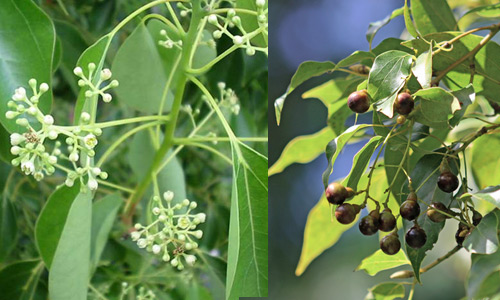|
Division
|
Angiosperms |
|
Class
|
Dicotledons |
|
Subclass |
Apetalae |
|
Order |
Laurales |
|
Family
|
Lauraceae |
|
Genus
|
Cinnamomum |
|
Species
|
camphora |

|
Etymology:
|
Kinamomon is the Arabic name and Greek coined it as kinnamonon. |
|
Botanical name:
|
Cinnamomum camphora (L.) J. Presl. |
|
Local/Trade Names: |
Camphor Tree |
|
Conservation status:
|
Cultivated at Forest Research Institute, Dehra Dun. |
|
Digonestic features:
|
Leaves smell like camphor. |
|
Description: |
Large evergreen tree. Leaves pale-green, glaucous, underneath, alternate, ovate-acuminate and leathery, with three distinct veins. Flowers yellowish or dull white, in panicles. Fruits small ovoid drupes, dark-purplish or reddish when ripe. |
|
Phenology: |
Fls.: Mar.-Apr. Frts.: Aug.-Nov. |
|
Distribution:
|
Native of China, Japan and Taiwan. |
|
Where to see it: |
Medicinal Plant Garden. |
|
Uses: |
Chipped wood of stems and roots is a source of natural camphor. Stems and leaves yield volatile oils, and seeds a white crystalline aromatic fat with high laurin content. Plant accredited with stimulant, diaphoretic, anthelmintic, antiseptic, and anodyne properties. Camphor Oil of commerce is the oil of C. camphora from which the camphor has been removed. Camphor is extensively employed in external applications as a counter-irritant in muscular strains, inflammations, and rheumatic conditions. Camphor is esteemed as an analeptic in cardiac depressions and is used in myocarditis. It has a calmative influence in hysteria and nervousness. |
Chief Conservator of Forests & Chief Wildlife Warden is the Head of the Department. There is one post of Conservator of Forests & two posts of Deputy Conservator of Forests viz.